Analyzing Action Express's second USC championshipby Gordon Kirby |
 Going into this year's Petit Le Mans no fewer than four teams had mathematical chances of winning the Tudor United SportsCar championship. But after a thoroughly rain-sodden race was red-flagged two hours short of full distance, defending champions Action Express with Joao Barbosa/Christian Fittipaldi/Sebastien Bourdais had once again prevailed.
Going into this year's Petit Le Mans no fewer than four teams had mathematical chances of winning the Tudor United SportsCar championship. But after a thoroughly rain-sodden race was red-flagged two hours short of full distance, defending champions Action Express with Joao Barbosa/Christian Fittipaldi/Sebastien Bourdais had once again prevailed.
Action Express's lead Coyote Corvette Daytona prototype finished third at Road Atlanta behind a pair of GT Le Mans cars. Nick Tandy's Porsche North America 911 RSR took the lead with only ten laps to go in the worst of the bad weather to score an historic first win for a GT car at Petit Le Mans. Lucas Luhr aboard one of Rahal-Letterman-Lanigan's GT Le Mans BMW Z4s finished an equally impressive second ahead of Barbosa/Fittipaldi/Bourdais's leading Daytona prototype. Chip Ganassi's Riley-Ford driven by Joey Hand/Scott Pruett/Scott Dixon came home fourth ahead of Action Express's second car driven by Eric Curran/Dane Cameron/Max Papis. "I never saw so much rain in my whole life!" two-time champion Fittipaldi exclaimed. "It was non-stop for three days. I started the race and I drove for two hours and I think the conditions then were the best of the whole race. Towards the end of my stint it started to get really bad and when I was getting ready to come in I ran over a puddle and spun! But I was able to get out of the gravel and not lose much time. "Right after that, all the mayhem started breaking loose as a consequence of the rain. The #90 flew off the road and a bunch of other things happened as it started to get worse and worse and worse. 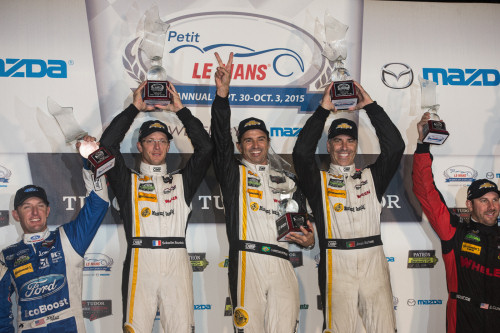 © JM Dias "Just as luck went against us at Mosport when we got a flat tire and they threw a yellow, so lady luck was with us at Road Atlanta. I think they made very good calls this year in the rain at Watkins Glen and again at Road Atlanta as far as when they threw the red flag. I think they were absolutely correct." Christian reflected on Action Express's second consecutive USC championship. "For sure, the highlight of the year was Sebring," he remarked. "Believe it or not, the car felt very difficult to drive, but despite that we were so much quicker than everyone else and scored a great win. "Definitely the lows of the year were the two west coast races at Long Beach and Laguna Seca. At Laguna we hit the bottom of the barrel. We would have been lapped at Laguna in twenty laps if there hadn't been a yellow flag. "We came back from Laguna and a few days later we were on the track to find out what we were doing wrong. We went to Road Atlanta to test and we tried the Laguna setup and we tried a normal Road Atlanta setup and it was a huge difference. It wasn't so much lap time as it felt so much better to drive. "We managed to dig our way out to the point where we went to Detroit for the next race and we were on the pole. You're talking about two completely different tracks, of course. But after that test we understood what we were doing. "I think Detroit was our strongest race. We had a problem with a GT car on a restart and that caused a chain reaction and Joao got passed by a couple of cars. It's almost impossible to pass at Detroit but we came back and finished third." Fittipaldi says the team's resiliency has been a key factor in winning successive championships. "I think our strong moments in general have been our ability to recover from when we were in trouble or had a bad race," he observes. "Our recovery time is very quick. When everything is going smooth, it's not so much easy as a little less hard. But things can only go smoothly for so long and then you're going to have some setbacks. "We always used Ganassi's guys as the yardstick. There was a period of time when they pretty much dominated the series. They were competitive but their recovery time from a bad race was night and day different compared to the other teams. 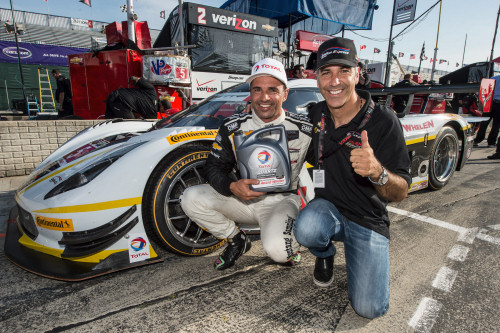 © JM Dias "I've been with Action Express now for four years, one year on and off, and three years full-time, and if you ask me what the biggest difference in the team is I think it's the ability to bounce back. I think our performance is all about preparation and doing what Ganassi has done for many years, and always trying to make it better." Action Express's chief engineer Iain Watt agrees with Fittipaldi. "We definitely used the negative energy that not doing well at Laguna created to inspire us," Watt remarked. "You've got to look in the mirror, recognize the problems and go about fixing those problems. "It wasn't clear at first, but it was clear within a week of finishing poorly and not understanding why. There was no smoking gun, but you could see what had led us to where we were and what had led us on the right path. "I spent a few years in NASCAR and I thoroughly enjoyed myself. I took it for what it was and learned from it and I'm a better person and better engineer for having worked in NASCAR. It opens your eyes to other things that you would otherwise not look at. Gary's NASCAR experience helps us in this way too. It's one of our strengths. "Our strengths are that we know our car and we recognize its strengths and weaknesses. We're always trying to make the weaknesses stronger and make sure that we're playing to our strengths. "We built the cars that finished one-two-three in the championship and this year we tried to run the same setup on both of our cars. The cars are mirror images of each other and that's another strength. Every driver wants to deal with something different, but we take the approach that we do what's best for the car, not what's best for the driver. "I mean that in a nice way because when a driver is new to our team they don't know what works with us. But it doesn't take them long to learn. We have very good drivers in both cars and the results this year have shown it." Fittipaldi was impressed by the performances turned in this year by Dane Cameron and Eric Curran, Action Express's regular drivers in its second car. "The way we worked with the #31 car this year was very good," Christian said. "Dane is very, very quick. He was pushing Joao and I all the time, and I think that helps us. The guy who was the biggest surprise to me was Eric. He showed very strong race pace this year. He was very solid in the races. I don't think I saw one single mistake from him during the races through the whole year." Fittipaldi says he couldn't have better teammates than Barbosa and Bourdais. 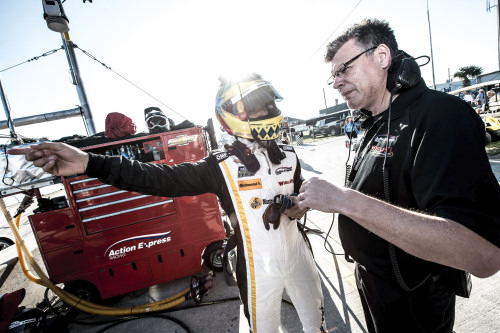 © JM Dias Christian also emphasizes the power in Gary Nelson's approach to racing. "Again, it all comes down to the preparation," he remarked. "The first email I got from Gary in 2011 said at the bottom of the email, 'Expect to win.' That caught my eye. I thought, 'Wow! What a cocky guy.' "But now I understand what he means by that. You've always got to think that you're going to win the race. You've got to be ready at any time if the situation falls in your lap, or however it happens. You've got to be ready to win the race. I think because of that thinking we've been able to capitalize on a bunch of different situations." Of course, in the end Action Express's back-to-back championships have been achieved through superb reliability. "At the end of two complete seasons," Christian emphasizes, "including two 24 hour races, two 12-hour races, two ten-hour races and two six-hour races, plus all the sprint races, the #5 car has completed every single lap, apart from one." Fittipaldi is 44 and has been racing cars for almost thirty years. His resume includes winning the FIA's F3000 championship in 1991 followed by three seasons in Formula 1 before spending eight years racing Indy cars. Christian finished second in his rookie and only Indy 500 start in 1995 with Derrick Walker's team then drove for Newman/Haas beside Michael Andretti from 1996-2002. He won at Elkhart Lake in 1999 beating Andretti in a Newman/Haas one-two and also won the following year's California 500. Christian has now established himself as one of this country's leading sports car racers along with Scott Pruett. "Scott is 55 and he's still going strong, so I still have a lot of wood to burn," Fittipaldi chuckles. "Life goes on. My daughter just turned five. She was happy that we won the championship. She understands the concept of winning and losing. But I remember when she was just a baby like it was yesterday. "Carl Haas always used to say, 'At the end of the day, luck always evens out. You can have some bad luck, but you will have some good luck as well. On balance, it will even out.' "I feel I was extremely lucky in Indy cars because I had a couple of bad accidents and got hurt, but I could have been hurt much more badly. And I've been able to go on and win championships in sports cars with Action Express. So to me, Carl was right. Luck evens out." Action Express will continue next year with the same cars, engines and drivers. "There was a chance that we were going to move on to a P2 car but we aborted that," Fittipaldi says. "We decided we need more time to think about which way we're going to go. An obvious option is an Oreca but then at the same time we need to see what the other manufacturers are going to come out with. So we're buying a little time to see what we're going to do in the longterm, starting in 2017." 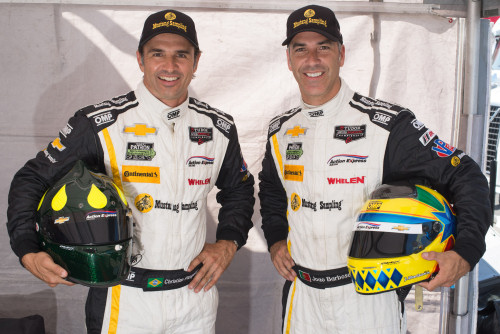 © JM Dias "In a year's time these cars will be finished, but in the meantime we'll be ramping up for whatever our program will be for 2017. We'll buy one of the approved four cars and we'll be taking a look at each car and the rules before we make any decisions." Fittipaldi believes IMSA and the USC series are moving in the right direction. "I think that, with any changes, there are going to be people who are going to like it and people who are not going to like it," Christian remarks. "There are going to be people who are comfortable and people who are going to be uncomfortable. "IMSA needs to fine-tune here and there, but I think it's setting itself up to be very strong. You can see it in the GTLM lineup. Next year Ford are coming in with a new GT car with Ganassi and I think there's plenty of interest in the series. "I think you'll see a bunch of new people in the prototype cars come into the series in 2017. They don't want to commit right now because there's no point in coming in for one season and fight with teams who have been running these cars for ten or fifteen years. But in 2017 they will have a chance because it will be a new formula with new cars for everybody. So I think we'll see a big change from 2017 onwards in the prototype class. "Having said that, I expect a grid of about twenty or more prototypes at Daytona and Sebring next year. I'm pretty sure some European cars will come over for Daytona and Sebring. I think it's all turning for the good. "At least we have a clear direction that we're going in. It may not be a hundred percent right, but we have a path to follow. If I compare IMSA to IndyCar, it's different because IndyCar doesn't have a path to follow. They seem to be shooting everywhere without a plan and have lost focus on the big picture. I think IMSA definitely has a plan. Maybe IMSA is wrong, but at least they are trying something and following a path. Time will tell whether it's right or wrong." Engineer Watt contemplated how IMSA's USC prototype category might evolve in the coming years. "I'm encouraged by what we see from IMSA," Watt commented. "It will be interesting to see how they engage the manufacturers. The FIA want manufacturers in LMP1 but they don't want manufacturers in LMP2. But IMSA want manufacturers in LMP2 and the teams need manufacturers to make it work. The LMP1 and P2 cars are pretty similar and we'll basically be racing non-hybrid LMP1 cars. "How do you badge a manufacturer on an LMP2 car? The P1 cars from Porsche and Audi don't look like their road cars. They're designed to be aerodynamically functional and you're only going to increase its functionality if you go down that path. 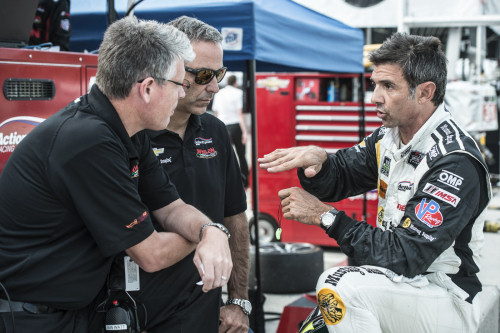 © JM Dias "Look at CART in the nineties when there were four engine manufacturers. You had Honda versus Ford versus Mercedes versus Toyota and those were good days for Indy car racing. It's always tough to keep that ball rolling and under control. They messed it up in Indy cars and we hope they do the job right in IMSA. "America needs a prototype series but I'm not sure what the right rules may be," Watt concluded. "Hopefully, they will make the right decisions and if they make the wrong ones, they will have to change them. But at the start, if they're going to make it successful they've got to get it more right than wrong." Ganassi's exciting new Ford GT program apart, next year's Weathertech United SportsCar championship will look pretty similar to this year's edition. But come the 2017 Rolex 24 Hours at Daytona we'll begin to get a better idea of what the future holds for the likes of Action Express and the USC as a whole. |
|
Auto Racing ~ Gordon Kirby
Copyright ~ All Rights Reserved |
